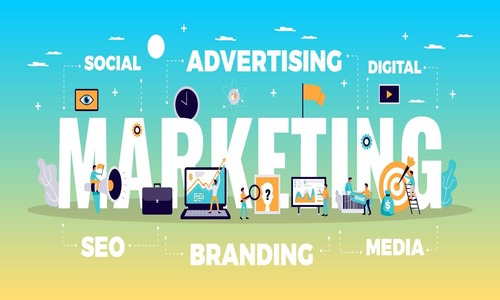Running a small business today means competing not just with local rivals, but also with well-funded brands that dominate online spaces. Digital marketing is your strongest tool to level the playing field. But the options feel endless – SEO, paid social, content, email funnels. Where do you even start?
Chances are, you’ve already tested the waters. Maybe you’ve started a blog or tried running ads, but nothing seems to line up with your efforts. You’re getting the traffic, but the conversions remain low.
What is it you’re doing wrong?
It might not be about working harder, but about working smarter with proven strategies. In this article, we’ll share some important digital marketing tips to help your small business attract the right audience and turn casual clicks into loyal customers.
Part 1. Core Digital Marketing Tips for Small Businesses
If you’re running a small business, digital marketing gives you the opportunity to compete with stronger competitors without needing massive budgets. When done right, it helps you become more visible online and bring in the right customers to grow your business.
Here are the essential digital marketing tips for beginners to execute it right.
1. Understand Your Target Audience
Your target audience is the specific people most likely to be interested in your product or service. Without knowing who will buy your products, what drives them, and where to find them, you cannot build a strategy that resonates with your customers.
To understand your audience better:
- Build Detailed Buyer Personas: Create simple profiles that describe your ideal customers, including who they are, what they need, and what motivates them.
- Map Out the Buyer’s Journey: Think about the steps people take before buying. This would include finding out about your business, considering your products, and making a decision to buy.
- Use Customer Feedback and Data: Conduct surveys and get reviews. Use website analytics to learn directly from your customers and adjust your approach.
2. Develop a Strong Content Marketing Plan
After knowing your audience, you need to create compelling content that attracts your ideal customers. Content marketing aims to give valuable information to your target audience that attracts them and drives conversions. Research by Content Marketing Institute shows that 58% of organizations find content marketing to be effective.
To make it work, you should address all stages of a customer’s sales funnel. Your content should align with their needs and pain points at these stages. This way, you can slowly guide them towards a purchase decision.
Use these digital marketing tips for startups when creating content:
- Create a diverse form of content like blogs, videos, infographics, etc.
- Post original content that reflects your brand’s core values.
- Repurpose content across multiple channels for maximum reach.
- Post frequently to stay in touch with your audience and build your SERP rankings.
- Address the needs and goals of your customers. Avoid over-promoting your products.

3. Optimize for Search Engines (SEO)
Creating content that resonates with your ideal customer is only half the equation. Making sure your audience can find it is just as important. That is where SEO (search engine optimization) can help. SEO is the process of improving your website (and its content) so search engines rank it higher whenever your audience searches for something.
Here are some digital marketing SEO tips:
- Use Relevant Keywords: Add words and phrases your customers actually search for.
- Create Quality Content: Write blogs, guides, or FAQs that answer your audience’s questions.
- Improve Website Speed: Your site should be easy to load and navigate. It keeps visitors from leaving your site.
- Ensure Mobile-Friendliness: Your site should work smoothly on phones and tablets.
4. Boost Your Social Media Presence
Social media marketing is one of the best ways for startups to connect directly with their customers. The key is starting with the right platforms. Think about where your audience actually spends their time. For example, Instagram and TikTok work well for younger audiences. Meanwhile, LinkedIn is better for professionals.
Once you’ve chosen the platforms, shift your focus to engagement. Consistency is everything, so stick to a posting schedule. Encourage user-generated content like reviews, photos, or testimonials. And don’t underestimate the power of live sessions. Real-time interaction can build trust and make your brand feel more human.
If you want to gather more traction, don’t forget about social media ads. You don’t need a huge budget to make an impact. With targeting, you can zero in on specific groups based on their interests and behavior. These approaches align perfectly with some of the most practical digital marketing branding tips. So, you’re not just attracting followers. You’re turning them into loyal customers.

5. Implement Effective Email Marketing
If you’re looking for tips on digital marketing, one effective area to focus on is email marketing. Unlike search engines, where algorithms control how visible your site will be to your customers, Email marketing connects you directly. It helps you send targeted messages directly to your audience’s inbox. As a result, you can build deeper relationships and encourage more sales.
According to the Content Marketing Institute, 71% of marketers use email newsletters to distribute their content. That’s a lot of people already connecting with their customers via email marketing. And if your business is not among them, you can easily fall behind in the competition.
Here are some tips to implement email marketing:
- Build Opt-In Lists Ethically: Use signup forms, lead magnets, or exclusive offers to encourage voluntary signups.
- Segment and Personalize: Group subscribers based on interests or behaviors and send messages tailored to their needs.
- Use Automation: Save time with automated sequences. This can be welcome emails or abandoned cart reminders to recover lost sales.
6. Launch Pay-Per-Click and Digital Ads
Pay-Per-Click (PPC) ads are among the practical tips for a digital marketing strategy. These are paid approaches where you only spend money when a searcher actually clicks on your ad. It’s one of the fastest ways for small businesses to get visibility and attract customers who are already interested in buying.
To make it work, pay close attention to your budget, your targeting, and your A/B testing. Don’t go all in at once. Start small, test different ad formats, and track your results before you scale up. A cost-effective way to use digital ads is retargeting ads. This means if someone visits your site but doesn’t convert, you can bring them back with tailored ads that remind them of what you offer. This keeps your brand top of mind, and it’s one of the most effective ways to boost conversions.
Part 2. Emerging Digital Marketing Tips and Tricks to Adopt Now
Your core strategies are the backbone of your marketing. They give you a solid foundation. But the trends in digital marketing never stay the same. To stay ahead, your business must adapt to new tools and shifting consumer habits. Right now, trends like AI and mobile-first strategies are opening up fresh opportunities to grow.
So, here are some digital marketing tips for 2025 and beyond.
1. Integrate AI and Automation Tools
Artificial intelligence has become an essential part of marketing in recent years. In fact, research from HubSpot’s Marketing Statistics shows that 54% of content marketers use AI to generate ideas. For small businesses and startups, this is especially powerful. AI can help you work smarter. Depending on your routine tasks and role, you can use it to save time on creating content and improving customer experiences.
For example, you can use AI to personalize emails and deliver experiences that feel one-to-one with customers. Beyond that, predictive analytics lets you spot trends before they fully emerge and anticipate what your customers will want next.
2. Prioritize Mobile Optimization
When discussing tips for digital marketing, mobile optimization is also at the top of the list. Data from Global Stats shows that 59.1% of internet traffic comes from mobile devices. So, what happens when your website isn’t mobile-friendly? You’re basically handing those potential customers over to competitors who offer a better experience to mobile users. And it’s not just about user experience. Google cares about it, too. With mobile-first indexing, Google prefers the mobile version of your site when deciding where to place you in search results.
So, how do you make sure your site is ready for mobile?
- Responsive Design: Your site should adjust automatically to any screen size, whether it’s a phone or a tablet.
- Faster Load Times: Optimize images, clean up your code, and invest in solid hosting so pages load quickly.
- Simple Navigation: Menus and buttons should be easy to tap with just a thumb.
3. Create Video and Interactive Content
Today, people are drawn to interactive and memorable experiences instead of just reading plain text. For small businesses, video content gives an opportunity to showcase their products and build stronger relationships with customers. Data from Wyzowl shows that 89% of businesses use video as a marketing tool. Moreover, 93% agree that video marketing gives them a positive ROI. These are huge numbers. And one of the best ways to ride this wave is video prospecting. These are short and personalized videos that introduce your brand, explain your offering, and accelerate the sales process.
4. Adapt to Voice Searches
More and more people are using smart speakers and mobile assistants like Alexa, Siri, and Google Assistant to ask questions out loud instead of typing them in. And this simple shift changes the way businesses need to think about optimization. In fact, NPR and Edison Research found that about 35% of U.S. households now own a smart speaker, which is speeding up the move toward voice commerce.
To adapt to voice searches, you need to understand that voice search isn’t the same as traditional SEO. People phrase things the way they talk, not the way they type. For example, instead of searching “best fast food in Orlando,” they might say, “What are the best fast food restaurants near me?” This means you need to pay attention to long-tail keywords and conversational language if you want to show up in these results.
Part 3. Measure, Test, and Optimize Your Efforts
Launching a campaign is just the beginning. A strong digital marketing strategy evolves when you continually test, measure, and refine your techniques. That’s how you can get the most ROI and stay ahead in an ever-competitive digital world.
Here’s what you can do to optimize your efforts.
Track your key performance metrics. Keep an eye on traffic, engagement, conversion rates, and ROI. These numbers tell you what’s working and what’s not. You can use tools like Google Analytics, HubSpot, and Ahrefs. These make it easier to spot patterns and turn data into decisions.
Run A/B testing and experiments. Try different versions of your ads, website designs, or even email subject lines. The results will reveal what’s truly resonating with your audience. This way, you can avoid guesswork and use data-backed insights to act on instead.
Scale and adapt what’s working. If a tactic is giving you positive results, put more budget behind it. But don’t lock yourself in. Algorithms and consumer behavior are always changing. The best strategies are the ones that adapt quickly and help you perform strongly.
Final Words
Digital marketing helps small businesses grow and compete effectively online. With these digital marketing tips, you don’t need a massive budget to stay ahead in the competition. The key is to narrow down on your target audience, track results, and refine your approach.
And if you want to make things easier, a professional in the field can make a huge difference. At PNC Logos, we help you get the most out of your digital marketing efforts with expert SEO, social media, and paid marketing services. If you’re ready to grow your startup into a recognized brand, get in touch with us today.





